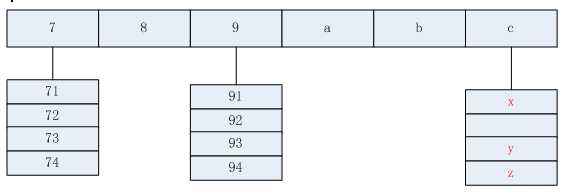标签:
首先,说下equals和hashCode的关系。JDK API中关于Object类的equals和hashCode方法中说过,总结起来就是两句话:equals相等的两个对象的hashCode也一定相等,但hashCode相等的两个对象不一定equals相等。
hashCode类似于一个位置值(不叫地址值,是想把每个对象所在的位置做地址值),HashSet、HashMap等集合类中常会用到。

上图中假设是对象在内存中的模型,则7—c就是位置值即hashCode,而71—74就是地址值。所以x,y和z的hashCode是一样的,但是x、y和z的equals不一定相等,equals相等只跟自己类定义的equals方法有关,加设备x是A类的对象,y类是B类对象,z是C类对象,A、B和C的equals都实现为始终返回true,则程序会认为x、y和z是相等的,若都实现为返回false,则x跟自己都不相等。即equals相等依据的是equals方法。
当我们重写equals方法时,是有要求的(具体见JDK)。如果只重写了equals,不重写hashCode会有什么影响呢?
假如该类不会放在HashSet等散列表相关的集合类中,不一定会有影响,如下代码:
Model类

1 package com.guanmu.test; 2 3 4 /** 5 * <p> 6 * 类描述: 7 * <p> 8 * 9 * 所属插件:com.guanmu.test 10 * 11 * @author guanmu 2015-10-20 12 * 13 */ 14 public class Model { 15 16 private String name; 17 private String age; 18 private String otherName; 19 20 /** 21 * @param name 22 * @param age 23 * @param otherName 24 */ 25 public Model(String name, String age, String otherName) { 26 super(); 27 this.name = name; 28 this.age = age; 29 this.otherName = otherName; 30 } 31 32 /** 33 * @return the name 34 */ 35 public String getName() { 36 return name; 37 } 38 39 /** 40 * @param name 41 * the name to set 42 */ 43 public void setName(String name) { 44 this.name = name; 45 } 46 47 /** 48 * @return the age 49 */ 50 public String getAge() { 51 return age; 52 } 53 54 /** 55 * @param age 56 * the age to set 57 */ 58 public void setAge(String age) { 59 this.age = age; 60 } 61 62 /** 63 * @return the otherName 64 */ 65 public String getOtherName() { 66 return otherName; 67 } 68 69 /** 70 * @param otherName 71 * the otherName to set 72 */ 73 public void setOtherName(String otherName) { 74 this.otherName = otherName; 75 } 76 77 @Override 78 public int hashCode() { 79 80 int a = 7; 81 int b = 11; 82 // a和b为不相等的int型常量 83 int r = a; 84 r = r*b + name.hashCode(); 85 r = r*b + age.hashCode(); 86 87 // return r; 88 return super.hashCode(); 89 } 90 91 @Override 92 public boolean equals(Object obj) { 93 if (!(obj instanceof Model)) { 94 return false; 95 } 96 97 Model other = (Model) obj; 98 if (name.equals(other.getName()) && age.equals(other.getAge())) { 99 return true; 100 } 101 102 return false; 103 } 104 105 /* (non-Javadoc) 106 * @see java.lang.Object#toString() 107 */ 108 @Override 109 public String toString() { 110 return "Model [name=" + name + ", age=" + age + ", otherName=" + otherName + "]"; 111 } 112 113 114 }
测试类

1 package com.guanmu.test; 2 3 import java.util.ArrayList; 4 import java.util.HashSet; 5 import java.util.List; 6 import java.util.Set; 7 8 /** 9 * <p> 10 * 类描述: 11 * <p> 12 * 13 * 所属插件:com.guanmu.test 14 * @author guanmu2015-10-20 15 * 16 */ 17 public class EqualsTest { 18 19 20 21 public static void main(String[] args) { 22 test1(); 23 test2(); 24 } 25 26 public static void test1() { 27 System.out.println("####:test1"); 28 List<Model> list = new ArrayList<Model>(); 29 30 Model a = new Model("a", "20", "test"); 31 Model b = new Model("a","20","abcdef"); 32 Model c = new Model("a","20",""); 33 34 list.add(a); 35 System.out.println("a-hashCode:" + a.hashCode()); 36 System.out.println(list); 37 if (!list.contains(b)) { 38 list.add(b); 39 System.out.println("b-hc:" + b.hashCode()); 40 System.out.println(list); 41 } 42 43 } 44 45 public static void test2() { 46 System.out.println("####:test2"); 47 Set<Model> set = new HashSet<Model>(); 48 49 Model a = new Model("a", "20", "test"); 50 Model b = new Model("a","20","abcdef"); 51 Model c = new Model("a","20",""); 52 53 set.add(a); 54 System.out.println("a-hashCode:" + a.hashCode()); 55 System.out.println(set); 56 if (!set.contains(b)) { 57 set.add(b); 58 System.out.println("b-hc:" + b.hashCode()); 59 System.out.println(set); 60 } 61 62 } 63 }
结果打印如下:
####:test1 a-hashCode:18923308 [Model [name=a, age=20, otherName=test]] ####:test2 a-hashCode:15136722 [Model [name=a, age=20, otherName=test]] b-hc:26752749 [Model [name=a, age=20, otherName=test], Model [name=a, age=20, otherName=abcdef]]
list中能判断出包含了等价的b,但set中认为a和b不相等,set中没有包含b。发现test1()中,ArrayList是根据equals来判断是后包含,而不管hashCode是否不相等。而test2()中,HashSet处理流程则不一样,先判断两个对象的hashCode方法是否一样,如果不一样,立即认为两个对象equals不相等,并不调用equals方法,当hashCode相等时,再根据equals方法判断两个对象是否相等。
总结,所以当我们缩写的类可能用于存放在Hash相关的集合类中时,在重写equals时,需要重写hashCode,不然会出现与预期不符的结果。从网上搜索了下如何重写hashCode方法,以下据说是《Think in Java》中提到的方法。
@Override public int hashCode() { int a = 7; int b = 11; // a和b为不相等的int型常量 int r = a; r = r*b + name.hashCode(); r = r*b + age.hashCode(); return r; }
其中a和b可以为任意不相等常量。
Java的重写equals但不重写hashCode方法的影响
标签:
原文地址:http://www.cnblogs.com/guanmu/p/4894430.html